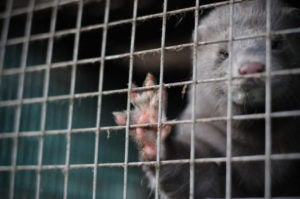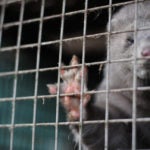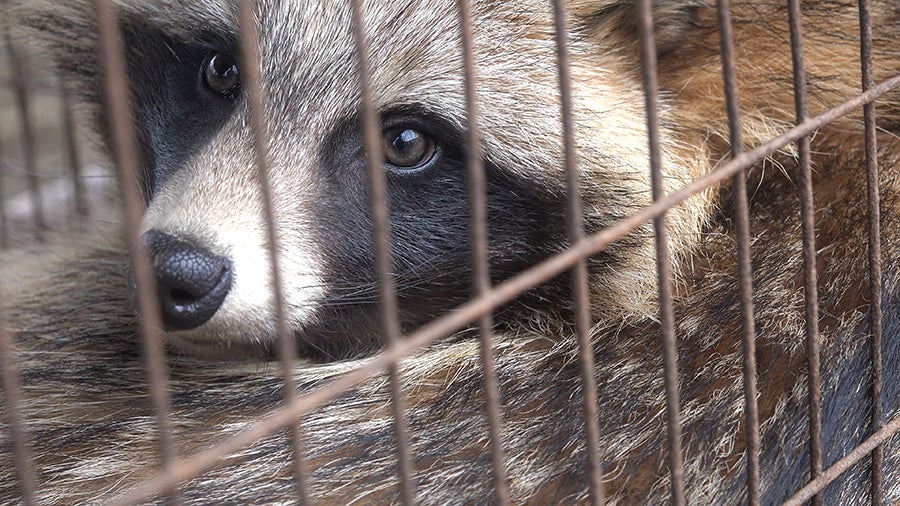
ROME—The Italian government has announced last night it will extend suspension of mink fur farming until 31 December 2021. The decision comes in the wake of the SARS-CoV-2 virus having been found on two mink farms so far in Italy. Italy has six fur farms with approximately 60,000 mink, 26,000 of whom were culled following the previous ordinance published in November last year by Italian Health Minister Roberto Speranza. Eleven countries in total (including nine EU member states) have now officially identified COVID-19 positive animals on mink farms: Denmark (290 farms), Netherlands (69 farms), Greece (23 farms), United States (16 farms), Sweden (13 farms), Spain (3 farms), Lithuania (2 farms), Canada (2 farms), Italy (2 farms), France (1 farm), Poland (1 farm).
Humane Society International, which campaigns globally for an end to the fur trade, welcomes the news but urges the Italian government to end the cruelty and public health risks by permanently ending fur farming. In December last year, HSI published a white paper highlighting the link between fur farming, poor animal welfare and infectious zoonotic disease.
Humane Society International’s director for Italy Martina Pluda, said: “While we applaud the Italian government for extending its temporary suspension of mink fur farming, to truly address the unacceptable risk of COVID-19 that fur farming represents, we urge it to permanently shut down this cruel and dangerous industry. Confining thousands of animals in small wire cages for fur production not only causes terrible suffering, but for as long as this exploitation is tolerated, and these wild species are crowded together in close proximity in low-welfare conditions, the potential for reservoirs of animal to human pathogens will persist.
Extending the temporary suspension is an important step, but if the government allows mink farming to start up again in 2022 in Italy, it will be placing the commercial interests of frivolous fur fashion ahead of the health of the public, and turning a blind eye to the suffering of thousands of animals.”
Earlier this month the European Food Safety Agency reported that all mink farms should be considered at risk for COVID-19 outbreaks. In January 2021, a Risk Assessment published jointly by the World Health Organization, the Food and Agriculture Organization of the United Nations, and World Organisation for Animal Health recognised Europe as a high-risk region in relation to the introduction and spread of SARS-CoV-2 within fur farms, in addition to the spill-over from fur farms to humans, and the transmission of SARS-CoV-2 from fur farms to susceptible wildlife populations. More specifically, it rated the risk factors and likelihood of introduction and spread of SARS-CoV-2 within fur farms in Italy as “likely”.
Fur Facts:
- On 27th October last year, it became publicly known that in August 2020 SARS-CoV-2 had been detected on a mink farm in Lombardy. This information only came to light after the submission of an information request by campaign organization LAV to the competent authorities. The OIE was only notified on 30th October.
- On 2nd February 2021 a further five positive tests were confirmed on a mink farm in the Veneto region. Furthermore, serology tests were performed on a sample of 60 mink, 90% of which showed antibodies, confirming that almost all animals on the farm had come into contact with the virus.
- An estimated 53 million mink are farmed for their fur in more than 20 countries around the world. The top three mink farming countries in Europe in 2018 were Denmark (17.6 million mink), Poland (5 million mink) and the Netherlands (4.5million mink). In August 2020 the Dutch government agreed to fast-track the permanent closure of its fur farms from a previous deadline of 2024 to January 2021 to prevent long term COVID-19 virus reservoirs forming on affected farms. Denmark killed all its mink in 2020 and has ended the keeping, import and export of mink until 31 December 2021; Sweden has suspended mink breeding and the movement of live mink until 31 December 2021; and mink fur farming has reportedly been halted in Belgium.
- China farmed 11.6 million mink for fur in 2019, a sharp decrease from 20.6 million mink in 2018.
- Fur farming has been banned in the UK since 2003. Over the past two decades, 21 countries have either voted to ban fur farming, prohibited the farming of particular species, or have introduced stricter regulations that have effectively curtailed the practice. These include numerous European nations such as Austria, Belgium, Bosnia-Herzegovina, the Czech Republic, Croatia, Macedonia, the Netherlands, Norway, Luxembourg, Serbia, Slovakia and Slovenia. Most recently the government in Hungary declared a ban on the farming of animals including mink and foxes, France committed to a phase out mink farms by 2025, and the Irish government made a commitment to bring forward legislation in 2021.
- Bulgaria, Estonia, Lithuania, Montenegro, Poland and Ukraine are also presently considering bans on fur farming and in Finland the majority party of the coalition government recently announced its support for a ban on fur farms.
ENDS
Media contacts:
- UK: Wendy Higgins, HSI director of international media: whiggins@hsi.org
- Italy: Martina Pluda, director of HSI in Italy: mpluda@hsi.org




